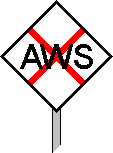|
|
|
|
|
|
Over the years, various safety systems have been introduced on Britain's railways to help drivers observe and obey signals and, to a lesser degree, speed restrictions. Some were implemented throughout almost the entire network, while others were confined to specific areas or routes. In general, all these systems function either by automatically applying the brakes in the event of a signal being passed at 'danger' (or in anticipation of a signal being passed at 'danger') or by providing audible and/or visual indications inside the driving cab, although usually they do both. Cab signalling presents movement authorities and permissible speed information to the driver on a display inside the train's cab instead of by lineside signals and signs. Even though these systems primarily give indications inside the cab, associated signs or indicators are sometimes needed at the lineside.
|
The mechanical trainstop system is employed on some urban DC electrified railways. Trainstops are installed beside the track at stop signals and certain other places. Each trainstop has a movable arm, which is raised when the associated signal is at 'danger'. The tripcock on a train that passes the signal at 'danger' will engage with the raised trainstop arm and cause a brake application. Tripcock testers and associated indicators are provided on the approaches to areas with trainstop protection to indicate to drivers that the tripcock on their train is correctly positioned. When a train approaches, the indicator illuminates to display the letters "TT" [12.1]. The indication remains lit until the train's tripcock depresses a sprung ramp on the tripcock tester, which is positioned close to the indicator. If the indicator continues to show "TT", the driver must assume that the train's tripcock is not in the correct position. |
|
In 1906, the Great Western Railway introduced its "audible cab signalling" system, which gave the driver an audible indication in the cab when approaching or passing a distant signal (see Section 2). Such faith was placed in the system that it was expected eventually to replace the distant signal at the lineside. The 'clear' indication was given by a bell. For the 'warning' indication, a siren would sound, which the driver could cancel by lifting a lever. From c.1910, the siren was accompanied by an automatic brake application and the system was renamed "Automatic Train Control" (ATC). Widespread fitment took place at distant signals on GWR lines.
Following nationalisation in 1948, British Railways set about developing an improved ATC system to become the new standard for use across the whole network. The resulting "Automatic Warning System" (AWS) was approved by the Ministry of Transport in November 1956. It incorporated a bell and warning horn in the cab in a similar fashion to the GWR ATC system. The driver must press and release an acknowledgement button to cancel the warning horn and the automatic brake application. An additional feature of AWS is the visual indicator. The indicator shows 'all black' when the train passes over the AWS equipment on the approach to a signal. If the signal is showing 'clear', a bell sounds and the indicator remains 'all black'. If the signal is showing 'caution' or 'danger', then as soon as the acknowledgement button is pressed, the indicator changes to a visually striking pattern of black and yellow segments, referred to as the 'sunflower'.
|
Before a locomotive equipped with Western Region AWS (ex-GWR ATC) apparatus could run over a fourth rail electrified line, its AWS shoe had to be clipped up to avoid the risk of it coming into contact with a live rail. A special high ramp placed in the 'four-foot' allowed the clipping-up of the shoe to be performed automatically. In the 1960s, Western Region diesel multiple units began running into Paddington Suburban station via the electrified lines of the London Underground. These units had more than one AWS shoe, and it had to be ensured that all were properly clipped up. After a train-borne shoe-checking system proved unsatisfactory, a track-based system was installed, which included a lineside indicator at the end of the clipping-up zone. This indicator comprised a blue light [12.2] situated ten yards (nine metres) on approach to the Up Suburban Line Home signal at Paddington Suburban. If the light remained lit as a train approached, it indicated to the driver that all AWS shoes were clipped up. If the light went out, it indicated that one of the shoes was not properly clipped up, in which event the driver was required to stop the train at the signal. |
|
|
A notice board was provided at places where the BR AWS system abutted the WR AWS system, lettered "B.R. A.W.S." or "W.R. A.W.S.", as appropriate [12.3]. |
|
At some through stations where the track layout was complex and speeds were low (30 mph or less), AWS equipment was not installed in the station area. In July 1965, the Operating Committee gave its approval to the provision of lineside signs marking the commencement and termination of an AWS gap. The commencement sign is a white circular board bearing the letters "AWS" and a red diagonal cross [12.4], while the termination sign bears the letters "AWS" on a white square [12.5]. Normally, no signs are provided to mark the boundaries between AWS-fitted lines and non-fitted lines; however, in recent years there has been a tendency to misuse these AWS gap signs for that purpose.
 |
 |
|
[12.4] Commencement of AWS Gap.
Area: All Areas Usage: High Status: Current |
[12.5] Termination of AWS Gap.
Area: All Areas Usage: High Status: Current |
|---|
On 6 June 1975, a high-speed derailment occurred at Nuneaton as a consequence of the lights in a gas-lit temporary speed restriction (TSR) warning board (see [14.19]) being extinguished. As a recommendation of the Department of Transport's report into the derailment, provision of AWS equipment was extended to include TSR warning boards. From September 1977, a portable temporary AWS magnet was to be installed on the approach to each warning board, to cause a warning indication to be given inside the cab of trains. Where a portable AWS magnet is installed on a single line, drivers will receive a warning indication regardless of the train's direction of travel. In this situation, a cancelling indicator is provided ahead of the magnet, in the opposite direction from the warning board, to advise drivers that the AWS warning just received must be cancelled in the usual way and then disregarded. The original form of cancelling indicator comprised a black square with a white diagonal cross, illuminated during darkness [12.6].
By 1981, cancelling indicators were being permanently installed at locations where it was not practicable to suppress the AWS equipment for movements to which it did not apply. Permanently installed cancelling indicators are reflectorised, although a few early examples were floodlit. The earliest examples of permanently installed indicators comprised a white square with a black diagonal cross [12.7], the opposite of their temporary equivalents. Concurrent with the introduction of blue TSR signs in 1981 (see Section 14), the colouring was altered to a white cross on a blue background [12.8] for both the temporary (illuminated) and permanent (reflectorised) forms of cancelling indicator. This uniformity ended in 1986, when illuminated cancelling indicators with a yellow background [12.9] were introduced for TSRs, while permanently installed cancelling indicators remained blue and reflectorised. Following the general introduction of reflectorised signs for TSRs in 1997, all cancelling indicators were reflectorised.
Simplified bi-directional signalling (SIMBIDS) was implemented on some routes between the years 1988 and 1995. This is an economical form of bi-directional signalling for use on double track railways worked by the Track Circuit Block system where wrong-direction movements are normally only made during emergencies or engineering work. A cost-saving feature of SIMBIDS is the absence of AWS for signals that apply in the wrong direction. Furthermore, the AWS provided for normal-direction signals is not suppressed, nor are any cancelling indicators provided. Lineside signs are provided to mark the start and finish of this special AWS working. Both signs are diagonal and contain the letters "AWS", and while the commencement sign also has a red diagonal cross [12.10], the termination sign does not [12.11].
 |
 |
|
[12.10] Commencement of Special AWS Working.
Area: All Areas Usage: Medium Status: Obsolescent |
[12.11] Termination of Special AWS Working.
Area: All Areas Usage: Medium Status: Obsolescent |
|---|
The opening of the line to the Channel Tunnel (from 1993) created the first interface between British Rail lineside signalling and a railway equipped with cab signalling. This was situated at the boundary between British Rail and Eurotunnel infrastructure at Dollands Moor, just west of the tunnel's UK portal. Lineside signs relating to the transition between the different signalling systems were provided in each direction. This included signs denoting the start and end of AWS, which were both similar to the standard 'AWS gap' signs (see [12.4 & 12.5]) but had white letters on a black background [12.12 & 12.13].
The approach to the cab signalling area is identified by one or more signs at the lineside with the word "cab" on a black background, indicating the commencement of cab signalling [12.14]. The cab signalling is enabled automatically, and the AWS is disabled. On the approach to a lineside signalling area, one or more signs indicating the end of cab signalling are provided. These were similar in appearance to the commencement sign, with the addition of a red diagonal stripe [12.15]. The AWS is enabled automatically, followed by the automatic disabling of the cab signalling.
 |
 |
|
[12.12] End of AWS.
Area: Dollands Moor Usage: Low Status: Historical |
[12.13] Commencement of AWS.
Area: Various Usage: Medium Status: Current |
|---|---|
 |
 |
|
[12.14] Commencement of Cab Signalling.
Area: Various Usage: Medium Status: Current |
[12.15] End of Cab Signalling.
Area: Various Usage: Low Status: Obsolescent |
|
The 'commencement of AWS gap' signs installed at both entrances to Daventry International Railfreight Terminal are a larger size than usual and have a non-standard red border [12.16]. |
|
|
|